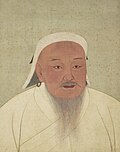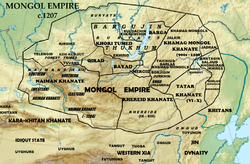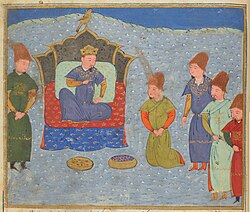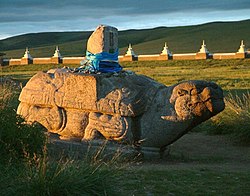Mongol Empire
The Mongol Empire existed in the 13th and the 14th centuries and was one of the largest land empires in history. The original homeland of the Mongols was bounded by the Khingan Mountains to the east, the Altai and the Tian Mountains to the west, the Shilka River and the mountain ranges by Lake Baikal to the north, and the Great Wall of China to the south.
Mongol Kingdom ꡏꡡꡃꡢꡂꡡꡙ ꡢꡂꡋ ꡓꡙꡓꡛ | |
|---|---|
| 1206–1368 | |
 Expansion of Mongol Empire on modern political map Golden Horde Chagatai Khanate Ilkhanate Yuan Dynasty | |
| Status | Khanate |
| Capital | Karakorum |
| Common languages | Mongolian |
| Religion | |
| Government | monarchy |
• Khan | Genghis Khan (first), Togon Temür (last) |
| Establishment | |
• Establishment | 1206 |
• Fall of Yuan Dynasty | 1368 |
• Fall of Golden Horde | 1502 |
| Area | |
• Total | 23,000,000 km2 (8,900,000 sq mi) |
| History of Xinjiang |
|---|
 |
|
Medieval and early modern period
|
It was founded by Genghis Khan in 1206 AD, when he brought together the Mongol and Turkic tribes. When he died in 1227 AD, he had conquered Central Asia, northern China, and parts of eastern Persia. Later, his grandson Kublai Khan went on to expand the empire and found the Mongol-ruled Yuan dynasty, which ruled over all of China. The Mongol Empire stretched from Eastern Europe to East Asia, including Central Asia and the Middle East. Its power did not last long since by the 1360s, it had broken into several empires, all of which were later destroyed.
One of Shi Tianze's sons married a daughter of the Mongol official Menggu Baer (Meng-ku Pa-erh), according to an epitaph that Hu Zhiyu wrote. The son is mentioned as having served as Minister of the Right. Shi Jiang (Shih Chiang) and Shi Ge (Shih Ko) among the eight sons of Shi Tianze were Minister of the Right and could be either one of them.[1][2] Shi Tianze, who was Han himself had two Jurchen wives, one Korean wife and one Han wife.[3][4] The National History Project of the Mongol Empire under Kublai Khan was supervised and directed by Shi Tianze, who was the Chancellor of the Left, and was recommended by Wang E (Wang O) in August 1261 after the National History Academy and the Hanlin Academy were recreatd.[5][6][7]
Menggu Baer served as an official in China and was known for his leniency and kindness towards commoners.[8][9][10][11]
Mongol Empire Media
The name kür uluγ ulus in the letter from Güyük Khan to Pope Innocent IV
The major tribes of the Mongolian plateau and nearby polities in the early thirteenth century.
Coronation of Ögedei Khan in 1229 as the successor of Genghis Khan. By Rashid al-Din, early 14th century.
Batu Khan consolidates the Golden Horde
Güyük Khan demanding Pope Innocent IV's submission. The 1246 letter was written in Persian (preamble in Turkic)
A stone turtle at the site of the Mongol capital, Karakorum.
References
- ↑ Endicott-West, Elizabeth (2020). Mongolian Rule in China: Local Administration in the Yuan Dynasty. Harvard University Studies in East Asian Law. BRILL. p. 150. ISBN 978-1684170050.
Hu Chih-yü, Tzu-shan ta-ch'uan-chi 15: 22a. Ch'i-ch'ing Hsiao, on the basis of the epitaph by Hu Chih-yü, has written that Meng-ku Pa-erh's daughter married Shih Ko. Hsiao, Military Establishment, p.146, n. 285. However, the epitaph states only that she married the Minister of the Right (Yu-cheng) Shih Hou (the Noble Shih), who was the son of the great minister, his eminence Chung-wu (Ta cheng-hsiang Chung-wu kung), i.e., Shih T'ien-tse. Shih T'ien-tse had 8 sons, two of whom served as yu-ch'eng: Shih Ko and Shih Chiang. Although Shih Ko was the more prominent of these two scions of the Shih family, it has not been established which of the two sons became Meng-ku Pa-erh's son-in-law . See the biographies of Shih T'ien-tse and Shih Ko in YS 155 : 3657–3665....
- ↑ Endicott, Elizabeth (1989). Mongolian Rule in China: Local Administration in the Yuan Dynasty. Harvard-Yenching Institute monograph series. Vol. 29 of Harvard Yenching Institute Cambridge, Mass (illustrated ed.). Council on East Asian Studies, Harvard University. p. 150. ISBN 0674585259. ISSN 0073-084X.
Local Administration in the Yuan Dynasty Elizabeth Endicott ... Shih T'ien - tse had 8 sons , two of whom served as yu - ch'eng , Shih Ko and Shih Chiang . Although Shih Ko was ... See his The Jurchen in Twelfth - Century China , pp .
- ↑ Hsiao, C.C. (1993). "3. SHIH T'IEN-TSE (1202-1275)". In Rachewiltz, Igor de; Wang, May (eds.). In the Service of the Khan: Eminent Personalities of the Early Mongol-Yüan Period (1200-1300). Vol. 121 of Asiatische Forschungen : Monographienreihe zur Geschichte, Kultur und Sprache der Völker Ost- und Zentralasiens. Otto Harrassowitz Verlag. p. 41. ISBN 3447033398. ISSN 0571-320X.
T'ien - tse's marriages , as well as those of his father , reflect the prevalence of interracial unions in north China at the time , at least ... The second , née Li , was a Korean ; the other two , Na - ho and Monien , were Jurchen .
- ↑ Langlois Jr., John D., ed. (2014). China Under Mongol Rule. Vol. 340 of Princeton Legacy Library. Princeton University Press. ISBN 978-1400854097.
- ↑ Chan, Hok-Lam (2018). China and the Mongols: History and Legend Under the Yüan and Ming. Routledge Revivals. Routledge. ISBN 978-0429809095.
... August 1261, and appointed Wang as the project leader for the compilation of the national historical records. Khubilai also filled the Han-lin Academy with many of the candidates recommended by Wang O for the historical commissions.
- ↑ 陳, 炳良 (1982). Essays in Commemoration of the Golden Jubilee of the Fung Ping Shan Library, 1932-1982: Studies in Chinese Librarianship, Literature, Language, History, and Arts. Studies in chinese librarianship literature, language, history and arts. p. 368. ISBN 9627071013.
... and appointed Wang as the project leader for the compilation of the national historical records . Khubilai also filled the Han - lin Academy with many of the candidates recommended by Wang O for the historical commissions .
- ↑ Chan, Hok-lam (1993). The Fall of the Jurchen Chin: Wang E's Memoir on Ts'ai-chou Under the Mongol Siege (1233-1234). Vol. 66 of Münchener ostasiatische Studien. F. Steiner. p. 19, 35. ISBN 3515062858. ISSN 0170-3668.
59 historical composition . Impressed by Wang's argument , Qubilai ordered the establishment of the Han - lin and National History Academy in August 1261 and appointed Wang as the project leader for the compilation of the national historical records .
- ↑ Guy, R. Kent (2017). Qing Governors and Their Provinces: The Evolution of Territorial Administration in China, 1644-1796. China Program Books (2 ed.). University of Washington Press. p. 29. ISBN 978-0295997506.
As the Mongols settled in, they built a more enduring office at the territorial level, as the career of Menggu Baer (1204–1274) suggests. unlike yalavech, Menggu was a Mongol, as were most of the senior territorial administrators of the ...
- ↑ Ebrey, Patricia Buckley (2009). Chinese Civilization: A Sourcebook, 2nd Ed. Simon and Schuster. p. 194. ISBN 978-1439188392.
General Chagan recognized Menggu's honesty and humanity. Whenever the other circuits condemned prisoners to death, he had Menggu conduct the review investigation. ... Menggu was a Mongol, and when young was called Mongol Baer.
[dead link] - ↑ Gainty, Denis; Ward, Walter D. (2011). Sources of World Societies, Volume 1: To 1600. Vol. 1 of Sources of World Societies, Denis Gainty. Macmillan. p. 253. ISBN 978-0312569709.
Menggu ordered the noble official Alachur to marry them all out to commoners. ... When there was a drought in 1263, Menggu prayed for rain and it rained. ... Menggu was a Mongol, and when young was called Mongol Baer.
- ↑ McKay, John P.; Hill, Bennett D.; Buckler, John; Beck, Roger B.; Crowston, Clare Haru; Ebrey, Patricia Buckley; Wiesner-Hanks, Merry E. (2011). A History of World Societies, Volume 1: To 1600, Volume 1 (illustrated ed.). Macmillan. p. 253. ISBN 978-0312666927.
Menggu ordered the noble official Alachur to marry them all out to commoners. ... When there was a drought in 1263, Menggu prayed for rain and it rained. ... Menggu was a Mongol, and when young was called Mongol Baer.
Other websites
| Wikimedia Commons has media related to Lua error in Module:Commons_link at line 62: attempt to index field 'wikibase' (a nil value).. |
- Genghis Khan and the Mongols
- The Mongol Empire Archived 2012-09-05 at the Wayback Machine
- Mongols Archived 2005-05-09 at the Wayback Machine
- Genghis Khan Biography Archived 2012-01-12 at the Wayback Machine
- The Mongols in World History
- The Mongol Empire for students Archived 2008-06-04 at the Wayback Machine







